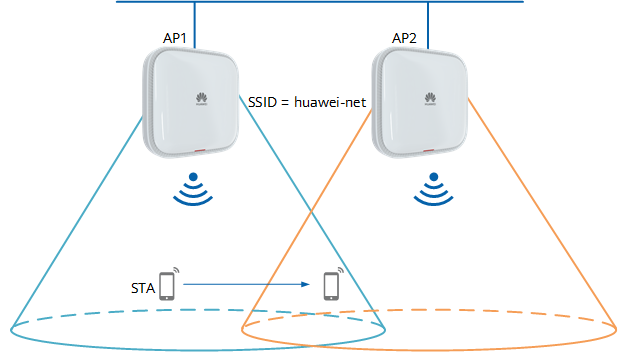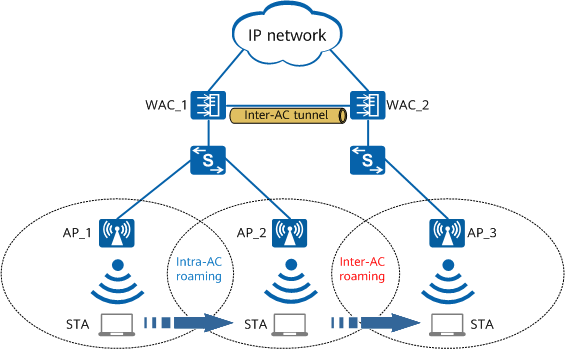What Is WiFi Roaming?
Wi-Fi roaming allows stations (STAs) to move within the coverage areas of access points (APs) belonging to the same extended service set (ESS) with nonstop service transmission.
The most significant advantage of the WLAN is that a STA can move within a WLAN without physical media restrictions. WLAN roaming allows the STA to move within a WLAN without service interruption. If multiple APs in an area use the same service set identifier (SSID), users can find this SSID on their STAs even if the STAs are connected to different APs. When a STA moves from the coverage area of an AP to that of another AP, Wi-Fi roaming ensures seamless transition of STA services between APs.
Why Is Wi-Fi Roaming Necessary?
The radio signals of an AP can cover only a limited area. When a STA goes away from the associated AP, it will receive only weak signals and finally disconnect from the WLAN if no Wi-Fi roaming is available. Network disconnection severely affects user experience of voice, video and other services.
This is where Wi-Fi roaming comes into play. As shown in the following figure, AP1 and AP2 provide the same network access service with SSIDs being huawei-net. When a STA moves from the coverage area of AP1 to that of AP2, the STA associates with AP2 and disconnects from AP1. During this process, Wi-Fi roaming ensures that the network connection is not interrupted. Simply put, it is similar to when we make a call on a mobile phone. When we move from the coverage area of one base station to that of another, the call is not disconnected.

Wi-Fi roaming
- Retains STAs' IP addresses. After roaming, a STA can still access the initially associated network and retain its services.
- Avoids packet loss or service interruption caused by long-time authentication.
How Does Wi-Fi Roaming Work?
Working principles of Wi-Fi roaming
A Wi-Fi roaming process typically includes the following phases:
- Triggering: After detecting that the downlink RSSI is lower than the threshold, a STA triggers the channel scanning process.
- Scanning: The STA discovers available APs at its current position through active or passive scanning and measures network information for network selection.
- Active scanning: The STA periodically sends a Probe Request frame. After detecting the Probe Request frame, APs respond to the STA with a Probe Response frame. After receiving the Probe Response frame, the STA detects the existence of the APs.
- Passive scanning: The STA listens on Beacon frames periodically sent by APs to detect them.
The specific scanning mode in use is typically determined by the scanning capabilities supported by STAs. For example, the wireless network adapter of a mobile phone or laptop supports both scanning modes, and VoIP STAs typically use the passive scanning mode.
- Selecting: An AP is selected as the roaming target based on the scanned AP information.
- Handover: A roaming mode that matches the network side is selected based on the STA and network capabilities.
Wi-Fi roaming classification
As shown in the following figure, STA roaming can be classified into Layer 2 roaming and Layer 3 roaming, depending on whether a STA roams within the same subnet. In Layer 2 roaming, a STA remains in the original subnet after roaming. In Layer 3 roaming, a STA roams between different subnets. (Roaming in the same VLAN pool is still Layer 2 roaming.) During WLAN planning, it is recommended that Layer 2 roaming be deployed for APs on the same floor and Layer 3 roaming for APs on different floors.

Layer 2 and Layer 3 roaming
Roaming can be classified into intra-AC roaming and inter-AC roaming, depending on whether a STA associates with the same WAC before and after roaming. As shown in the following figure, when a STA roams from AP_1 to AP_2, it associates with the same WAC and roams within the same WAC. When the STA roams from AP_2 to AP_3, it associates with different WACs before and after roaming and roams between WACs. During WLAN planning, it is recommended that intra-AC roaming be deployed in the same building and inter-AC roaming between buildings for medium- and large-sized campus networks.

Intra-AC roaming and inter-AC roaming
Development of Wi-Fi Roaming
The roaming handover time is a key factor that affects WLAN service experience during roaming. The conventional Wi-Fi roaming technologies basically ensure service continuity when STAs move from the coverage of an AP to that of another. However, conventional Wi-Fi roaming still faces many issues, which affect the roaming handover time. Roaming technologies are continuously developing to cope with these issues.
Fast roaming
- Fast roaming using PMK caching
The fast roaming uses the PMK caching technology defined in IEEE 802.11i. During roaming, a WAC searches the PMK caching table based on the PMK-ID in the Reassociation Request frame. If a match is found, the WAC considers that the STA has passed 802.1X authentication and only needs to complete key negotiation. The fast roaming shortens the roaming handover time of 802.1X STAs through PMK caching, thereby improving users' WLAN experience.
- 802.11r fast roaming
The 802.11r protocol defines the Fast BSS Transition (FT) function that reduces the number of information exchanges in a mobility domain (MD) and does not require 802.1X authentication or key negotiation during STA roaming. In this manner, users are unaware of any in-roaming service interruption and experience low-latency data services during roaming, improving user experience.
Note that the two above-mentioned fast roaming mechanisms require the support of STAs.
Smart roaming
Some STAs on a WLAN have low roaming aggressiveness. As a result, they stick to the initially connected APs regardless of whether they move far from the APs, and have weak signals or low rates. The STAs fail to roam to neighbor APs with better signals. They are called sticky STAs.
Smart roaming enables sticky STAs to roam to neighbor APs with better signals promptly, improving STA service experience and implementing load balancing between APs.
In smart roaming, an AP collects the signal-to-noise ratio (SNR) and access rate of STAs in real time. If the signal strength of a STA is detected to be lower than the threshold for multiple times within a period of time, the STA is considered as a sticky STA. The AP reports the sticky STA information to the WAC which then selects a target AP suitable for the sticky STA to roam to and delivers the target AP information to the current AP. Then the current AP instructs the STA to roam to the target AP based on the BSS transition mechanism defined in the 802.11v protocol or by disconnecting the STA.
AI roaming is an enhancement of smart roaming technology. A WAC provides personalized roaming steering policies for different types of STAs and starts roaming steering at a proper time through the coordinated measurement mechanism, thereby effectively improving the roaming sensitivity and success rate as well as resolving sticky STA issues.
Roaming optimization in specific scenarios
In addition to fast roaming, smart roaming, and AI roaming, Huawei WLAN also optimizes roaming technologies based on service characteristics in specific scenarios.
For example, the automated guided vehicles (AGVs) are typically used in the smart warehousing scenario. AGVs access the WLAN through CPEs. Controlling and scheduling AGVs exerts higher requirements on the real-time performance, reliability, and concurrency capability of WLANs. In this scenario, the automatic navigation roaming optimization can be enabled.
Suggestions on Wi-Fi Roaming Deployment
Good WLAN planning is the prerequisite for users to obtain good Wi-Fi roaming experience. Professional WLAN planning is required before WLAN deployment. Based on previous experience, WLAN planning and deployment documents in different scenarios are summarized below, including recommended AP models in different scenarios, AP deployment solutions, and Wi-Fi roaming KPIs (roaming success rate, average roaming delay, and in-roaming packet loss rate). For details, see the following table.
Scenario |
Network Planning Material |
|---|---|
Enterprise office |
|
Education |
|
Shopping mall and supermarket |
Scenario-based WLAN Planning Design for Shopping Mall and Supermarket |
Retail |
|
Healthcare |
|
Warehouse |
|
Hotel |
|
Shop floor |
|
Airport |
|
Rail transport |
|
Mine |
|
Port |
|
Outdoor |
|
Backhaul |
|
Stadium and venue |
|
Triple-radio AP application |
- Author: Zhao Fangfang
- Updated on: 2024-02-27
- Views: 14038
- Average rating:







